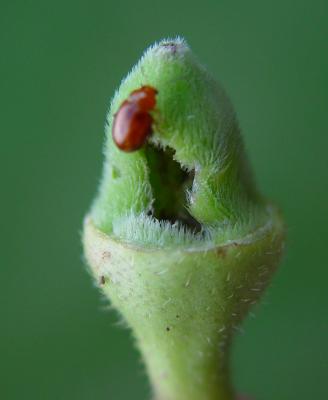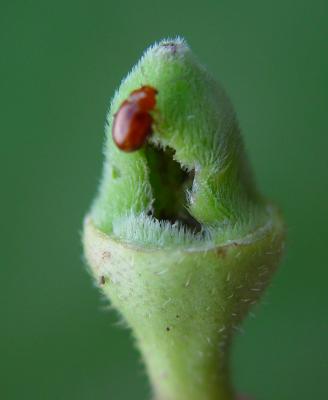

Flea beetles (Podagrica spp)
They are 1.5 to 3 mm long with well-developed hind legs. They are named for their habit of jumping like fleas when disturbed. The colour of the adult beetles varies from black, brown, black and yellow striped or metallic blue-green depending on the species. Adult flea beetles chew small round holes (shot holes) in leaves, giving them a sieve like appearance. On rare occasions, they may feed directly on ripe fruit, just below the calyx. This damage is usually seen only in plants that show extreme foliar stress resulting from lack of water or powdery mildew. The larvae of flea beetles live in the soil and feed on roots, but the damage caused is not of economic importance. Adult flea beetles can be particularly damaging to young plants. Seedlings are most vulnerable to flea beetle feeding when stressed, particularly by inadequate moisture. Older plants can withstand considerable leaf perforation.
- Monitor the crop frequently, particularly during the first stages of the crop. Even a small flea beetle population can cause significant damage to a crop in the cotyledon or first-leaf stages.
- Provide good nutrition and favourable growing conditions. This helps to avoid plant stress from diseases and moisture, and helps plants survive flea-beetle attack.
- Weed in and around fields. This may help to eliminate flea beetle shelter and breeding grounds, reducing crop damage.
- Keep plant diversity in the farm. Living mulches or polycultures are known to reduce flea-beetle damage. Diversity in the farm supports populations of natural enemies.
- When necessary spray botanicals or other alternative products. Extracts of neem, rotenone, pyrethrin, sabadilla, garlic, onion and mint alone or in combination have been recommended for control of flea beetles. Insecticidal soap is reported to give partial control of flea beetles. However, sprays combining rotenone with insecticidal soap are considered very effective. Diatomaceous earth and rock powders have been observed to reduce flea-beetle populations but applications must be renewed regularly after rainfalls.
